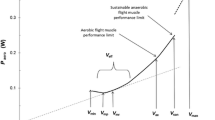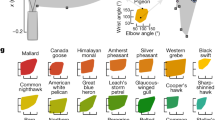Abstract
Previous bat aerodynamic power models are refined by (1) varying the value of wing profile drag with lift coefficient, which varies with both flight speed and Reynolds number, (2) allowing for the aerodynamic cleanliness of head, body, ears and tail in calculating parasitic drag values at various speeds and according to airframe type, (3) incorporating models of wingbeat amplitude and frequency in the power calculations, and, (4) upgrading the allometric, phylogenetically corrected relationship between basal metabolic rate and body mass using data from 98 bat species. The fidelity of the aerodynamic power model is assessed using published wind tunnel data on a bat in steady glide. By comparing empirical published metabolic power (P met) values with values derived using the new aerodynamic model, we update estimates of in-flight musculoskeletal mechanical efficiency (η) for the airframes of eight bat species at steady level flight speeds. Furthermore, we calculate the increase in η at high speeds. The bats assessed range in body mass from 0.01 to 1 kg, and the comparison covers the speed range normally used by free-flying bats during their excursions. At their best endurance flight speeds (V end), η = 1.52 Ln (m bat) + 11.44 (%). At speeds > V end, η = η@ Vend + 1.3 (V−V end) (%). These equations yield accurate P met estimates for flight speeds within the range used for the steady level flight.







Similar content being viewed by others
Abbreviations
- AR :
-
Aspect ratio
- B :
-
Span (m)
- C D :
-
Three-dimensional lifting surface drag coefficient = 2 D/ρ/S ref/V 2
- C d :
-
Two-dimensional airfoil section drag coefficient
- C L :
-
Three-dimensional lifting surface lift coefficient = 2 L/ρ/S ref/V 2
- C l :
-
Two-dimensional airfoil lift coefficient
- D :
-
Drag (N)
- f w :
-
Wingbeat frequency (Hz)
- g :
-
Acceleration due to gravity = 9.81 m s−2
- L :
-
Lift (N)
- m :
-
Bat mass (kg)
- P :
-
Power (W)
- q :
-
Dynamic pressure = ½ ρV 2 (N m−2)
- Re :
-
Reynolds number
- R :
-
Pearson’s correlation coefficient
- S :
-
Area of a lift or drag generating surface of body (m2)
- T :
-
Time (s)
- t :
-
Thickness, e.g. body thickness (m)
- V :
-
Bat flight speed (m s−1)
- v :
-
Local airflow velocity (m s−1)
- w :
-
Width, e.g. body width
- η :
-
Mechanical efficiency (%)
- θ:
-
Wingbeat amplitude—empirical above or below the body axis reference dorsal plane (degrees)
- ρ:
-
Air density = 1.2256 kg m−3 at sea level and 15 °C
- ω:
-
Wingbeat angular velocity (rad s−1)
- (1 + δ):
-
Induced drag factor accounting for effect of non-elliptical wing spanwise lift distribution
- body:
-
Body
- dot:
-
Acceleration
- ear:
-
Ear
- head:
-
Head
- h/t:
-
Tail membrane (uropatagium)
- ind:
-
Indicated
- max:
-
Maximum condition
- mech:
-
Mechanical
- pro:
-
Profile
- para:
-
Parasitic
- ref:
-
Reference condition
- sh:
-
Shoulder
- true:
-
True airspeed
- w:
-
Wing
- wd:
-
Wing disk (area)
- wr:
-
Wrist
References
Pennycuick, C.J.: Mechanics of flight. In: Farner, D.S., King, J.R. (eds.) Avian biology. Academic Press, New York (1975)
Norberg, U.M., Kunz, T.H., Steffensen, J.F., Winter, Y., Von Helversen, O.: The cost of hovering and forward flight in a nectar-feeding bat, Glossophaga soricina, estimated from aerodynamic theory. J. Exp. Biol. 182, 207–227 (1993)
Muijres, F.T., Johansson, L.C., Barfield, R., Wolf, M., Spedding, G.R., Hedenström, A.: Leading-edge vortex improves lift in slow-flying bats. Science 319, 1250–1253 (2008)
Persson, P.-O., Willis, D.J., Peraire, J.: Numerical simulation of flapping wings using a panel method and a high-order Navier–Stokes solver. Int. J. Numer. Method Eng. 1, 1–20 (2011)
Thomas, S.P.: Metabolism during flight of two species of bats, Phyllostomus hastatus and Pteropus gouldii. J. Exp. Biol. 63, 273–293 (1975)
Carpenter, R.E.: Flight physiology of flying foxes, Pteropus poliocephalus. J. Exp. Biol. 114, 619–647 (1985)
Carpenter, R.E.: Flight physiology of intermediate-sized fruit bats (Pteropodidae). J. Exp. Biol. 120, 79–103 (1986)
Winter, Y., von Helversen, O.: The energy cost of flight: do bats fly more cheaply than birds? J. Comp. Biol. B 168, 105–111 (1998)
von Busse, R., Swartz, S.M., Voigt, C.C.: Flight metabolism in relation to speed in Chiroptera: testing the U-shape paradigm in the short-tailed fruit bat Carollia perspicillata. J. Exp. Biol. 216, 2073–2080 (2013)
Norberg, U.M.: Vertebrate flight. Springer, Berlin (1990)
Rayner, J.M.V.: On aerodynamics and the energetics of vertebrate flapping flight. Contemp Math 141, 351–400 (1993)
Rayner, J.M.V.: Estimating power curves of flying vertebrates. J. Exp. Biol. 202, 3449–3461 (1999)
Lindhe Norberg, U.M., Winter, Y.: Wing beat kinematics of a nectar-feeding bat, Glossophaga soricina, flying at different flight speeds and Strouhal numbers. J. Exp. Biol. 219, 3887–3897 (2006)
Tian, X., Iriarte-Diaz, J., Middleton, K., Galvao, R., Israeli, E., Roemer, A., Sullivan, A., Song, A., Swartz, S., Breuer, K.: Direct measurements of the kinematics and dynamics of bat flight. Bioinspiration Biomimetrics 1, S10–S18 (2006)
Hedenström, A., Johansson, L.C., Wolf, M., von Busse, R., Winter, Y., Spedding, G.R.: Bat flight generates complex aerodynamic tracks. Science 316, 894–897 (2007)
Pennycuick, C.J.: Modelling the flying bird. Academic Press, London (2008)
Hedenström, A., Muijres, F.T., von Busse, R., Johansson, L.C., Winter, Y., Spedding, G.R.: High-speed stereo DPIV measurement of wakes of two bat species flying freely in a wind tunnel. Exp. Fluids 46, 923–932 (2009)
Hubel, T.Y., Hristov, N.I., Swartz, S.M., Breuer, K.S.: Changes in kinematics and aerodynamics over a range of speeds in Tadarida brasiliensis, the Brazilian free-tailed bat. J. R. Soc. Interface 9, 1120–1130 (2012)
Hedenström, A., Johansson, L.C., Spedding, G.R.: Bird or bat: comparing airframe design and flight performance. Bioinspiration Biomimetics 4, 015001 (2009)
Hubel, T.Y., Hristov, N.I., Swartz, S.M., Breuer, K.S.: Time-resolved wake structure and kinematics of bat flight. Exp. Fluids 46, 933–943 (2009)
Hubel, T.Y., Riskin, D.K., Swartz, S.M., Breuer, K.S.: Wake structure and wing kinematics: the flight of the lesser dog-faced fruit bat, Cynopterus brachyotis. J. Exp. Biol. 213, 3427–3440 (2010)
Bullen, R.D., McKenzie, N.L.: Scaling bat wingbeat frequency and amplitude. J. Exp. Biol. 205, 2615–2626 (2002)
Bullen, R.D., McKenzie, N.L., Spoelstra, G.: Can some Australian bats take advantage of flat-plate aerodynamics? ACTA Chiropterologica 15, 171–184 (2013)
Shyy, W., Aono, H., Chimakurthi, S.K., Trizila, P., Cesnik, C.E.S., Lui, H.: Recent progress in flapping wing aerodynamics and aeroelasticity. Prog. Aerosp. Sci. 46, 284–327 (2010)
Pennycuick, C.J.: The mechanics of bird migration. Ibis 111, 525–556 (1969)
Weis-Fogh, T.: Energetics of hovering flight in hummingbirds and in drosophilae. J. Exp. Biol. 56, 79–104 (1972)
Tucker, V.A.: Bird metabolism during flight: evaluation of a theory. J. Exp. Biol. 58, 689–709 (1973)
Grodzinski, U., Spiegel, O., Korine, C., Holdreid, M.W.: Context dependent flight speed: evidence for energetically optimal flight speed in the bat Pipistrellus kuhlii. J. Anim. Ecol. 78, 540–548 (2009)
Hoerner, S.F.: Fluid dynamic drag. Hoerner Fluid Dynamics, New Jersey (1965)
Pennycuick, C.J.: Bird flight performance: a practical calculation manual. Oxford University Press, Oxford (1989)
Bullen, R.D., McKenzie, N.L.: Bat wing airfoil and planform structures relating to aerodynamic characteristics. Aust. J. Zool. 55, 237–247 (2007)
Schmitz F.W.: Aerodynamics Of The Model Airplane. Part 1. Airfoil Measurements (1942). Translated at Redstone Scientific Information Center RSIC-721 (1967)
Simons, M.: Model aircraft aerodynamics. Nexus Special Interests, Hemel Hempstead (1999)
Bullen, R.D., McKenzie, N.L.: Bat airframe design: flight performance, stability and control in relation to foraging ecology. Aust. J. Zool. 49, 235–262 (2001)
Bullen, R.D., McKenzie, N.L.: Aerodynamic cleanliness in bats. Aust. J. Zool. 56, 281–296 (2009)
Pennycuick, C.J., Obrecht, H.H., Fuller, M.R.: Empirical estimates of body drag of large waterfowl and raptors. J. Exp. Biol. 135, 253–264 (1988)
Bullen, R.D., McKenzie, N.L.: The pelage of bats (Chiroptera) and the presence of aerodynamic riblets: the effect on aerodynamic cleanliness. Zoology (Jena, Germany) 111, 279–286 (2008)
Cruz-Neto, A.P., Jones, K.E.: Exploring the evolution of the basal metabolic rate in bats. In: Zubaid, A., McCracken, G.F., Kunz, T.H. (eds.) Functional and evolutionary ecology of bats. Oxford University Press, Oxford (2006)
Cheverud, J.M., Dow, M.M.: An autocorrelation analysis of genetic variation due to lineal fission in social groups of rhesus macaques. Am. J. Phys. Anthropol. 67, 113–121 (1985)
Jones, K.E., Purvis, A., MacLarnon, A., Bininda-Edmonds, O.R.P., Simmons, N.B.: A phylogenetic supertree of the bats (Mammalia: chiroptera). Biol. Rev. 77, 223–259 (2002)
Alexander, R.M.: Energy for animal life. Oxford University Press, Oxford (1999)
Norberg, U.M., Rayner, J.M.V.: Ecological morphology and flight in bats (Mammalia: chiroptera): Wing adaptations, flight performance, foraging strategy and echolocation. Philos. Trans. Zool. Soc. Lon. B 316, 335–427 (1987)
Pennycuick, C.J.: Gliding flight of the dog-faced bat Rousettus aegyptiacus observed in a wind tunnel. J. Exp. Biol. 55, 833–845 (1971)
Bishop, C.M.: Heart mass and the maximum cardiac output of birds and mammals: implications for estimating the maximum aerobic power input of flying animals. Philos. Trans. R. Soc. Lond. B. 352, 447–456 (1997)
Speakman, J.R., Thomas, D.W.: Physiological ecology and energetics of bats. In: Kunz, T.H., Fenton, M.B. (eds.) Bat ecology. University of Chicago Press, Chicago (2003)
Spedding, G.R.: The wake of a kestrel (Falco tinnunculus) in gliding flight. J. Exp. Biol. 127, 45–57 (1987)
Full, R.J.: Mechanics and energetics of terrestrial locomotion: bipeds to polypeds. In: Wieser, W., Gnaiger, E. (eds.) Energy transformations in cells and organisms, pp. 175–182. Thieme, Stuttgart (1989)
Dial, K.P., Biewener, A.A.: Pectoralis muscle force and power output during different modes of flight in pigeons (Columba livia). J. Exp. Biol. 176, 31–54 (1993)
Askew, G.N., Marsh, R.L., Ellington, C.P.: The mechanical power output of the flight muscles of blue-brested quail (Coturnix chinensis). During take-off. J. Exp. Biol. 204, 3601–3619 (2001)
Ward, S., Moller, U., Rayner, J.M.V., Jackson, D.M., Nachtigail, W., Speakman, J.R.: Metabolic power of European starlings Sturnus vulgaris during flight in a wing tunnel, estimated from heart transfer modelling, doubly labeled water and mask respirometry. J. Exp. Biol. 207, 4291–4298 (2004)
Morris, C.R., Nelson, F.E., Askew, G.N.: The metabolic power requirements of flight and estimates of flight muscle efficiency in the cockatiel (Nymphicus hollandicus). J. Exp. Biol. 213, 2788–2796 (2010)
Vaughan, T.A.: The muscular system. In: Wimsatt, W.A. (ed.) Biology of bats, vol. 1, pp. 140–193. Academic Press, New York (1970)
Bullen, R.D., McKenzie, N.L.: Bat flight-muscle mass: implications for foraging strategy. Australian Journal of Zoology 52, 605–622 (2004)
Acknowledgments
We wish to thank the Western Australian Department of Parks and Wildlife for providing laboratory facilities used during the preparation of this manuscript. Information on branch lengths used to calculate the distance matrix for the phylogenetic correction of BMR data was provided by Kate Jones (Institute of Zoology, UK).
Author information
Authors and Affiliations
Corresponding author
Rights and permissions
About this article
Cite this article
Bullen, R.D., McKenzie, N.L. & Cruz-Neto, A.P. Aerodynamic power and mechanical efficiency of bat airframes using a quasi-steady model. CEAS Aeronaut J 5, 253–264 (2014). https://doi.org/10.1007/s13272-014-0104-5
Received:
Revised:
Accepted:
Published:
Issue Date:
DOI: https://doi.org/10.1007/s13272-014-0104-5




